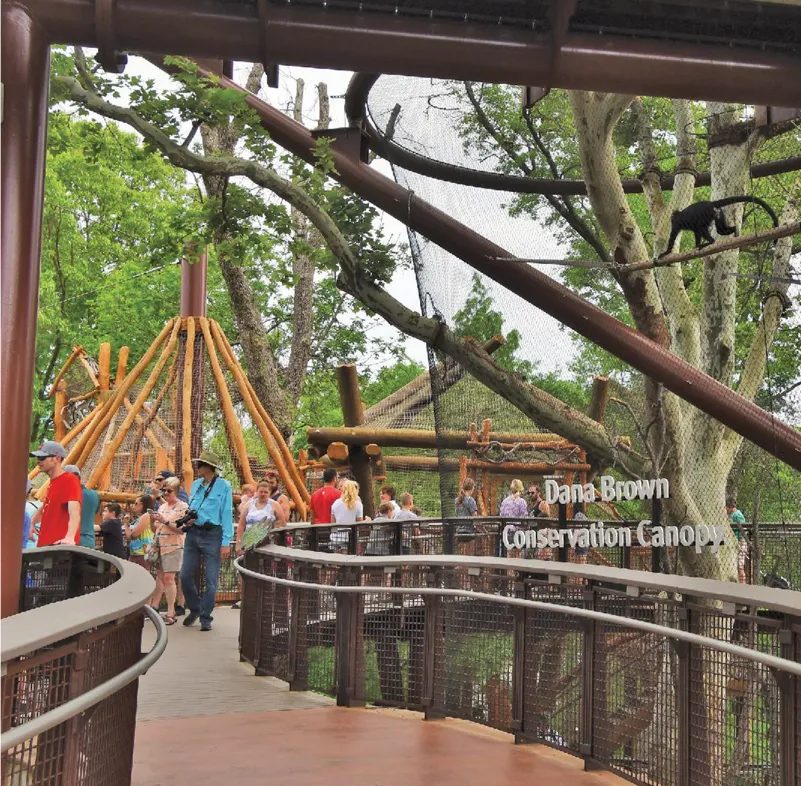Above: An elevated winding steel boardwalk allows visitors to explore the 35,000-sq.-ft. primate habitat among the mammals and treetops
March, 2024- Over the last two decades, actors from dozens of motion pictures ranging from Mission Impossible-Fallout to Jumanji: The Next Level, Rambo and Captain America: The Winter Soldier, have uttered the pithy two-word expression, “It’s complicated.”
It’s a phrase Craig Wehrmann, general manager for The Gateway Company of Missouri LLC, likes to use to describe the types of jobs at which the steel fabrication contractor excels. With projects ranging from access and work platforms to large pipe bridges and entire buildings, Gateway also has paint and blast booths on site for surface preparation and value-added coatings. At home with materials that include carbon steel alloys, stainless and aluminum, Gateway is uniquely equipped.
“We do the jobs that scare others,” says Wehrmann. In 2020, Gateway won a bid for a “mission impossible” contract that landed the company a 2023 Merit Award from the American Institute of Steel Construction (AISC). Gateway has been an AISC member for more than two decades. It earned the Ring-tailed lemur distinction for the Saint Louis Zoo’s Michael and Quirsis Riney Primate Canopy Trails project in the sculpture/art/installation/non-building structure category.
The 35,000-sq.-ft . primate habitat and guest experience, deemed the first of its kind, allows visitors to explore the forest floor through a seethrough tunnel framed in steel and reach the treetops via an elevated winding steel boardwalk. The exhibit contains enrichment play areas as well as shelters for lemurs and Old and New World monkeys in eight different habitats.
“The challenge on this project was the need to have things fit precisely at the locations where they were intended to be,” says Mark Trimble, senior vice president for AISC. That required a lot of coordination between the fabricator, the contractor and the detailer, and a lot of unusual layout techniques. Given the way those walkways snake through the site, the ups and downs, the almost roller-coaster-ride-type curves, this project could not have been made with anything other than steel.

Ring-tailed lemur
“The way the paths are nestled through the trees seems almost natural. And with uncoated weathering steel, it just blends right into the background. It makes me wonder what those monkeys think about when they’re looking at us humans as we walk down the path, if they’re wondering maybe we are the monkeys.”
DEMANDING DESIGN
“This project had a little bit of everything,” says Wehrmann, who was also project manager. “It was not a commodity steel job. Most people see those rolled structures and want nothing to do with them. Complex painting, rolled stainless that’s our niche.”

Forming the spine of the boardwalk are sections of 14-in. OD pipe.
The Saint Louis Zoo tapped PGAV Destinations, a local architect, for the habitat’s design. Also weighing in on the design was structural engineer Kansas City, Missouri-based Leigh & O’Kane. General contractor Tarlton Corp. issued bids to subcontractors and awarded the job to Gateway.
Originally the entire project called for Cor- Ten weathering steel. The design had to be adapted due to sizing restrictions. “[Grade] A588 CorTen wasn’t available in some sizes, such as the pipe needed to construct the walkway’s spine and 12-in. OD curved members used to create steel ‘trees’ in three of the habitats,” says Wehrmann. “These types of pieces were changed to standard carbon steel and painted with a highperformance rust brown coating to match the weathered steel look. Brackets also had to be attached to these members and precisely fabricated to follow the curve of those metal trees.

The boardwalk comprises 15 modules, each with its own unique curve and elevation
“The biggest challenge,” he continues, “was working with large-diameter pipe. None of it is perfect coming out of the mill. But we had to make sure it all fit together perfectly before it left our shop.”
The overhead boardwalk melded painted and curved round hollow structural sections to create the spine, which supported weathering steel plates, channels and mesh.
The Max Weiss Co., an AISC associate member, helped Gateway put some of the puzzle pieces together. “We do all of Gateway’s bending and rolling,” says David Nader, senior estimator/senior project manager for Max Weiss. “They’ve been a customer of ours for close to two decades.”
The job shop can bend pipe from 1 in. up to 20 in., steel beams up to 36 in., and channels up to 18 in. “Usually, we bend 30 or 40 of the same size product for a job,” says Nader. “This project had 500 different components. No two were the same. It was extremely labor intensive.”

Grade A588 Cor-Ten steel channels form the base of the walkway
STRICT TOLERANCES
Max Weiss rolled C6x8.2# channels from A588 Cor-Ten steel with the flanges up [the hard way of the web] for the base of the walking path. “There are seven of those channels side by side that snake around to make up the boardwalk,” says Nader. “It’s supported by 20 pieces of 14- in. OD pipe making up the spine.”
Incremental benders designed and built by Max Weiss in the 1970s give the job shop a unique edge by maintaining strict tolerances while minimizing distortion. “It’s what we’re good at,” says Nader. It took the job shop three to four months to complete the components before shipping them to Gateway for fabrication.
“They’ve been a great partner,” says Wehrmann. “They were able to provide the demanding tolerances we needed for this job.”

The project consumed roughly 150 tons of steel and took about three months to install
Transitioning design plans into a 2D format that equipped Gateway personnel with the details needed to fabricate the steel profiles from Max Weiss into modules for the walkway presented another obstacle. The boardwalk comprises 15 modules, each with its own unique curve and elevation. Bolted connections for the modules’ individual profiles had to align perfectly with the walkway’s spine and the straight mesh panels that lined it.
Joe Nicoloff at Nicoloff Detailing deciphered and converted the renderings for Gateway. “Joe used SDS2 detailing software to draw all of the walkways, the sunshades, and the rigging tie-off locations,” says Wehrmann. “And he did most of it from a hospital bed. He had leukemia and passed away in September 2021.”
Over roughly nine months, Gateway welded, plasma cut and fabricated pipe, spiral stairs and shields to protect visitors from animal waste. Sunshades were added to keep the primates cool. Seventeen heated shelter boxes constructed from Cor-Ten with access locations for wiring and mountings for heating were engineered to keep the animals warm during cold weather. The shelter boxes were plasma cut in a semi-circle and rolled with a wood backing inserted.

Boardwalk components were modeled and fabricated to exact angles to ensure successful erection while preserving the habitat’s forest.
The fabrication shop had to meticulously maintain a set of coordinates so that rolled members intersected at just the right places. Each bracket attached to the curved sections were custom fabricated by hand to match the curve of the tube. Three steel halos were att ached to hold the mesh netting made to enclose the habitat. Each halo was a different size and shape and was fabricated at a precise radius. The brackets attaching the halos to the steel trees were hand calculated for the right angle to ensure erection in the field could be performed without hitting the site’s natural sycamore and blue ash trees.
ADA COMPLIANCE
“The trees couldn’t be touched or damaged, so each component had to be modeled and fabricated to exacting angles to ensure successful erection in the field while preserving the habitat’s forest,” says Wehrmann. “There was very little wiggle room.”
“What visitors can’t easily see is that this is a very long sloped walkway,” he continues. “And because the structure had to be ADA compliant, elevation was limited. We were required to build flat spots into the walkway so nothing was straight.”
Once fabrication was completed, Gateway shipped all the components to the zoo site. The pieces were laid out on the ground using GPS coordinates from the detailer’s models. The work was staged and carefully orchestrated between Gateway, the erector, the general contractor, subcontractors and ironworkers. The project consumed approximately 150 tons of steel and took close to three months to install. Before the habitat opened to the public in July 2021, Gateway took its personnel to see the finished exhibit.
“They were awestruck about how it all went together,” says Wehrmann. “Most of the time a structural fabricator’s work is covered up. In this case, it’s something people can see and use. It will be here 75 years from now. My kids and grandkids can see the work we did. My first fabrication job was with this zoo. They have another large project planned. Hopefully, I can end my career with it.”
For Dave Nader, the primate canopy trails habitat was a career highlight but he adds that the individuals behind these types of projects also make the work fulfilling. “The steel business is unique,” he says. “It’s filled with honest, educated, knowledgeable people. It’s a tight community.”
American Institute of Steel Construction, 312/670-2400, aisc.org
The Gateway Company of Missouri LLC, 314/524-7440, gatewaycompany.com
Max Weiss Company LLC, 888/649-3477, maxweiss.com












